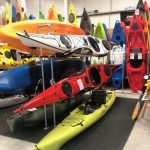Want an inflatable kayak that can take 2 persons on board? In this guide, we will walk you through what you should consider when choosing an inflatable tandem.

In a hurry? Our pick as the best modular kayak is Pakayak Bluefin 142
What do you do if you live in a compact apartment without space enough to store a full-sized kayak, or you drive a small sedan without rails for a rooftop kayak carrier?
How do you enjoy a summer of paddling without spending a small fortune renting kayaks everywhere you go?
The answer is simple: get yourself a modular kayak.
Modular kayaks are exactly what they sound like—a kayak that comes in sections that can be assembled to form a full, functional kayak, but disassembled into multiple parts and packed small enough to fit in any car trunk and storage space.
They’re far from cheap (you’ll pay more for a modular kayak than a regular hard-shell and definitely more than an inflatable) but incredibly portable and versatile.
To learn more about modular kayaks, including what they are, how they work, and what makes them a good choice for you, you’ve come to the right place!
Below, we’ll take a deep dive into everything you need to know about kayaks, as well as look at all the most important buying factors to consider.
By the end of this post, you’ll be ready to test out one of these highly practical kayaks for yourself. Who knows, you must just love it as much as I do!
As an affiliate of Amazon and other retailers, we may earn a small commission when you buy via our links, at no additional cost to you. Thank you!
Quick List: The Best Modular Kayaks for You
Don’t have time to read the full article? Don’t sweat it! Here’s a quick list of the best modular kayaks for you to consider:
- Best Overall: Pakayak Bluefin 142
- Point 65N Martini GTX
- Point 65N Mercury GTX Sit-In
- Point 65N Tequila! GTX Sit-on-Top
- Point 65N Kingfisher
- Point 65N Falcon
Comparison table: The Best Modular Kayaks
| Model | Specs | Where To Buy |
Pakayak Bluefin 142 | Assembled Length: 14’2″ Sections: 6 Weight: 59 lbs. Weight Capacity: 300 lbs | PAKAYAK |
Point 65N Martini GTX | Assembled Length: 9’4”(solo)/ 13’8” (tandem) Sections: 2 (solo)/ 3 (tandem) Weight: 48.5 lbs (solo )/ 77 lbs (tandem) Weight Capacity: 265 lbs (solo )/ 530 lbs (tandem) | Amazon |
Point 65N Mercury GTX Sit-In | Assembled Length: 13’6” (solo)/ 18′ (tandem) Sections: 3 (solo)/ 4 (tandem) Weight: 55 lbs. (solo)/ 77 lbs (tandem) Weight Capacity: 286 lbs. (solo)/ 530 lbs (tandem) | Amazon |
Point 65N Tequila! GTX Sit-on-Top | Assembled Length: 9’7” (solo)/ 13’6” (tandem) Sections: 2 (solo)/ 3 (tandem) Weight: 48.5 lbs. (solo )/ 77 lbs (tandem) Weight Capacity: 265 lbs. (solo)/ 530 lbs (tandem) | Amazon |
 Point 65N Kingfisher | Assembled Length: 11′ (solo)/ 16′ (tandem) Sections: 2 (solo)/ 3 (tandem) Weight: 70 lbs. (solo )/ 108 lbs (tandem ) Weight Capacity: 287 lbs (solo)/ 573 lbs (tandem) | Amazon |
Point 65N Falcon | Assembled Length: 8’8” (solo )/ 12’9” (tandem) Sections: 2 (solo)/ 3 (tandem) Weight: 40 lbs. (solo )/ 60 lbs (tandem ) Weight Capacity: 220 lbs. (solo)/ 485 lbs (tandem) | Amazon |
Modular Kayak Reviews
Best Overall: Pakayak Bluefin 142

Assembled Length: 14’2″ (431.8 cm)
Sections: 6
Weight: 59 lbs. (26.8 kg)
Weight Capacity: 300 lbs (136 kg)
Pakayak isn’t known only for its modular kayaks—they have a wide range of other hard-shell models—but the second-generation Bluefin 142 has earned its place at the top of our list because of its durability, reliability, and overall performance.
The high-performance touring-style kayak comes in 6 easy-to-connect sections, with a tongue and groove design, silicone gaskets, and stainless steel latches that ensure the entire kayak is very sturdy when assembled. Unlike the Point 65N kayaks below, you can carry it full and sit on it fully assembled, all without damaging the joints. The patented clamping system ensures that your kayak is fully waterproof even in high-wind and choppy conditions, making it great for crossing large lakes, paddling along the coastline, or even sea touring.
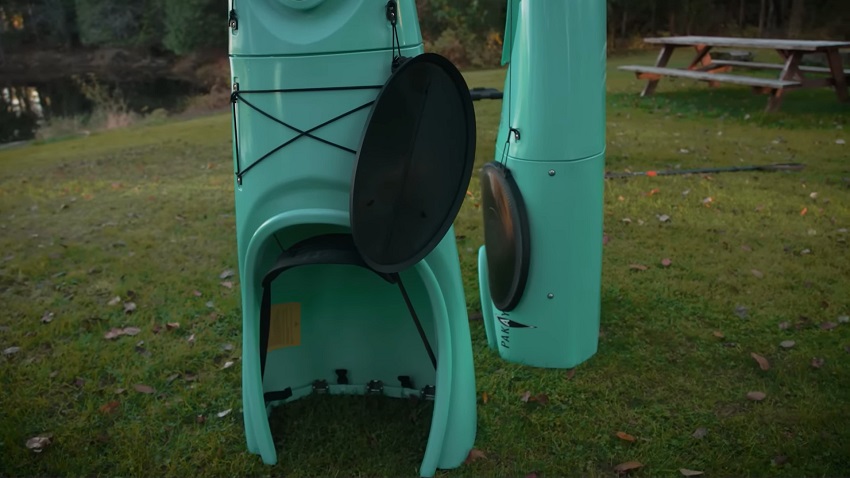
When packed, it’s 3 ½ feet long (42” inches), but assembles into a 14+ footer that is sleek and light enough (at 59 pounds) to slice through the water at an impressive speed. Handling and tracking is spectacular, and made a whole lot better with the addition of a rudder system (available at an extra cost). Best of all, the zipper bag you pack the kayak in comes with wheels that makes transporting the packed-up kayak a breeze.
Point 65N Martini GTX

Assembled Length: 9’4” (284.48 cm) (solo configuration)/ 13’8” (416.56 cm) (tandem configuration)
Sections: 2 for solo, 3 for tandem
Weight: 48.5 lbs. (22 kg) (solo configuration)/ 77 lbs (35 kg) (tandem configuration)
Weight Capacity: 265 lbs. (120.2 kg) (solo configuration)/ 530 lbs (240.4) (tandem configuration)
The Martini GTX is one of Point 65N’s best-known and best-selling models, a highly stable recreational kayak that’s ideal for kids and adults both. It assembles using the brand’s patented Snap-Tap system, which makes assembly and disassembly a breeze. Thanks to its modular design, you can switch it between a solo and tandem kayak in a matter of seconds.
The hard-shell kayak is made using MatriX 1-Layer PE, an ultra-tough plastic that can handle the rigors of recreational use and regular UV exposure without cracking or weakening. The kayak comes with both a rudder and integrated skeg that makes handling a breeze. It’s stable enough that even newbies will have no trouble staying upright when the wind kicks up and the water’s surface gets choppy.
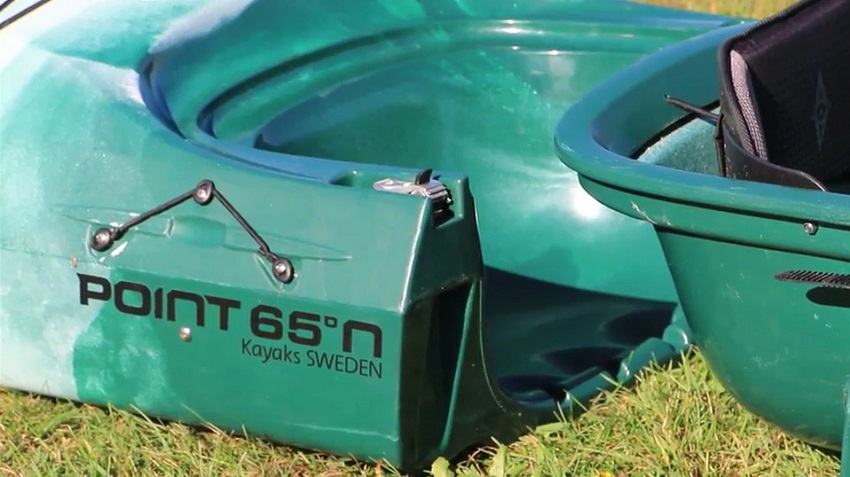
Other great features include multiple cup holders, thigh braces, compatibility with spray skirts, and the patented AIR-Backrest seat, which allows for pneumatic adjustments for your ideal comfort, as well as a durable honeycomb-patterned cover over EVA foam. In solo form, it’s 9’4” and weighs just 48.5 pounds.
Point 65N Mercury GTX Sit-In

Assembled Length: 13’6” (411.48 cm) (solo configuration)/ 18′ (548.64 cm) (tandem configuration)
Sections: 3 for solo, 4 for tandem configuration
Weight: 55 lbs. (25 kg) (solo configuration)/ 77 lbs (35 kg) (tandem configuration)
Weight Capacity: 286 lbs. (129.7 kg) (solo configuration)/ 530 lbs (240.4 kg) (tandem configuration)
If you want a touring kayak capable of slicing through the waves off-shore or handling the currents of the Great Lakes, you’ll love the Mercury GTX. The sit-inside kayak is built sleek, slim, and long enough that it handles like a dream while being both speedy and responsive. Best of all, it’s got a large cockpit well-suited to taller users.
The weight capacity isn’t the best—286 pounds in solo configuration and 530 lbs in tandem configuration—but you’ll have storage space enough in the watertight front and aft compartments to store your necessary equipment. Assembly and disassembly is made easy thanks to the brand’s signature Snap-Tap locking system, and you can get it from your car into the water and back again in a matter of minutes. As expected from a long kayak, it’s definitely a bit on the heavier side, so you’ll want to transport the kayak in modules rather than fully assembled.
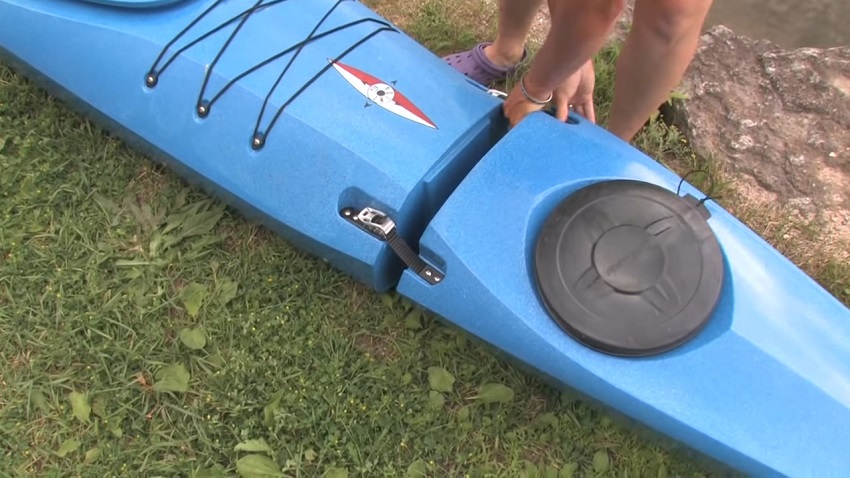
It features the same comfortable AIR seat and flush rudder and skeg as the Martini GTX, and is backed by a 1-year warranty to ensure you get only the most reliable kayak for your money.
Point 65N Tequila! GTX Sit-on-Top

Assembled Length: 9’7” (292.1 cm) (solo configuration)/ 13’6” (411.48 cm) (tandem configuration)
Sections: 2 for solo, 3 for tandem
Weight: 48.5 lbs. (22 kg) (solo configuration)/ 77 lbs (35 kg) (tandem configuration)
Weight Capacity: 265 lbs. (120.2 kg) (solo configuration)/ 530 lbs (240 kg) (tandem configuration)
Anglers, this one’s for you! The Tequila! GTX is the ideal fishing kayak, with a sit-on-top design, plenty of room to move around, and excellent primary stability. Though it doesn’t include mounts or rails to add accessories, it does have tons of open storage space to hold your coolers and bait boxes, and AIR seats that will stay comfortable even after a long day of sitting and fishing.
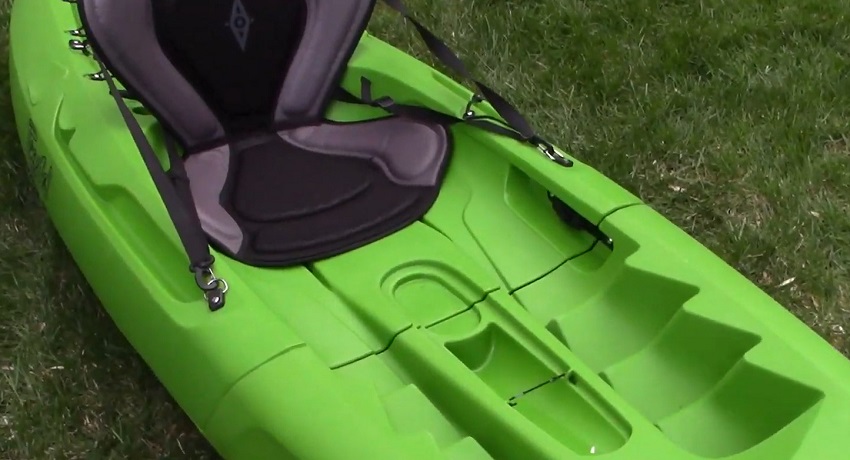
As with all Point 65N kayaks, it’s easy to configure in both tandem and solo—just snap on an extra section to lengthen the kayak. Even if you’re solo-paddling, you’ll find that adding the tandem section increases stability and gives you a lot more room to move around and store fishing gear.
There’s integrated drainage (scupper holes) to ensure your cockpit stays dry, four-position foot braces that make it easy to configure the kayak to your preferences, and bungee rigging in the stern tankwell to secure your cooler or tacklebox in place. Plus, there’s a cup holder to keep your coffee or beer close at hand!
Point 65N Kingfisher
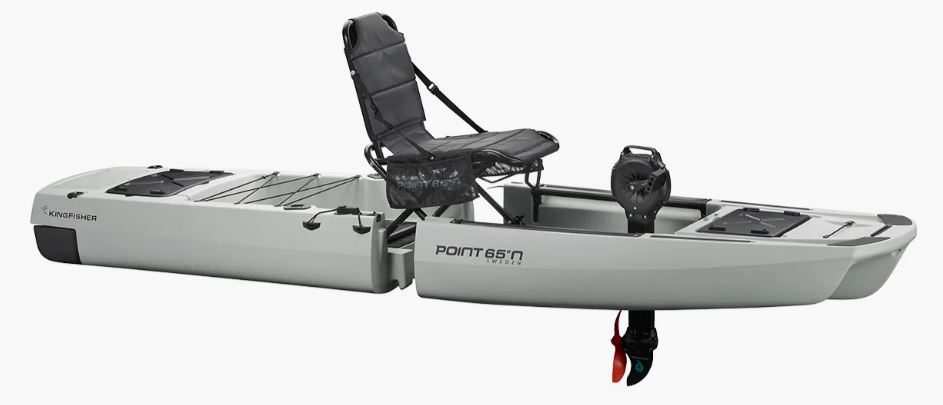
Assembled Length: 11′ (335.28 cm) (solo configuration)/ 16′ (487.68 cm) (tandem configuration)
Sections: 2 in solo, 3 in tandem configuration
Weight: 70 lbs. (31.75 kg) (solo configuration)/ 108 lbs (49 kg) (tandem configuration)
Weight Capacity: 287 lbs. (130.2 kg) (solo configuration)/ 573 lbs (260 kg) (tandem configuration)
For those who are serious about kayak fishing, this is the modular kayak you’ll want to consider. Its trimaran hull offers amazing primary stability—enough you can fish standing up—but its sleek, speedy, and responsive. You’ll love the integrated dual rudders as well as the option to integrate the ImpulseDrive pedal system, making it easy to zip upriver or around the lake to find where the fish are biting. Thanks to its eight integrated scupper holes, you’ve got plenty of drainage to keep the cockpit dry even when the spray is up.
But the real game-changer is the KingFisher Game Chair, an ultra-comfortable elevated seat that gives you more control over your rod and makes it easier to power the pedal system. You can make minute adjustments in the seat’s position to give you the most comfortable option for a long day of fishing.
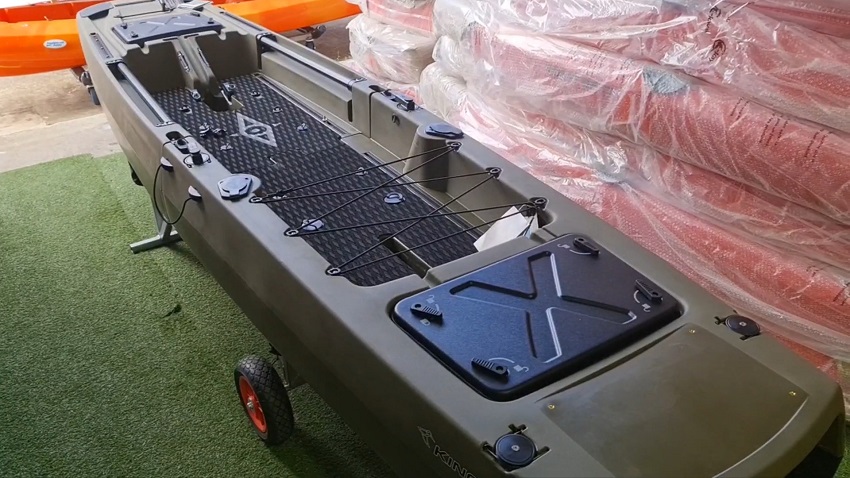
Compared to some of the other kayaks on our list, the Kingfisher is a bit on the heavier side—a whopping 70 pounds when in solo configuration—but that’s due to the extra-sturdy, ultra-stable trimaran hull. You’ve got slightly better-than-average weight capacity, and plenty of room to move around to stay comfy all day long. There’s also marine-grade aluminum rails along the floor to mount accessories to, paddle parks on both sides (compatible with fishing nets, too), and a rear platform sturdy enough for and compatible with a trolling motor mount.
Point 65N Falcon

Assembled Length: 8’8” (264.16 cm) (solo configuration)/ 12’9” (388.62 cm) (tandem configuration)
Sections: 2 for solo, 3 for tandem configuration
Weight: 40 lbs. (18.1 kg)(solo configuration)/ 60 lbs (27.2 kg) (tandem configuration)
Weight Capacity: 220 lbs. (99.8 kg) (solo configuration)/ 485 lbs (220 kg) (tandem configuration)
The Falcon is Point 65N’s best warm-weather model, a sit-on-top recreational kayak that makes it easy to get in and out of the water and enjoy a long day of paddling under the bright summer sun. It’s sized small enough to fit even into your most compact sedan or coupe, or even strapped onto a yacht or motorboat. When the time comes to paddle, just snap it all together in a minute and you’re good to go.
Weighing in at just 40 pounds, it weighs about as much as the average hard-shell kayak, though thanks to its short length (8’8”) and lower-than-average weight capacity (220 lbs.), it’s better-suited to smaller adults, teenagers, and children who want to paddle alone. The flip-up backrests and molded plastic seats give you decent seating for a few hours of relaxing paddling, though you won’t want to use this kayak for a full day or overnight trip.
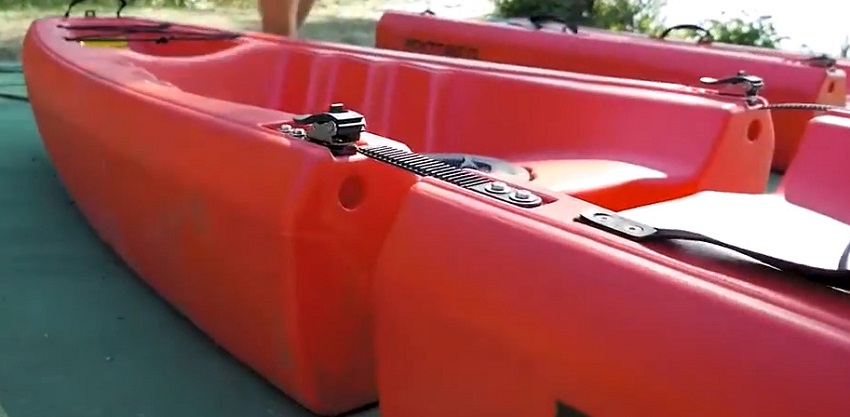
The recessed tankwells in the fore and aft give you space for gear storage, or keeping a cooler handy so you can drink while paddling. The hatches on the front and rear sections ensure everything stays securely in place, though you’ll need to make sure your items are secured in a dry bag or will survive getting wet. It’s inexpensive, ultra-portable, and a great recreational kayak to use when the sun is high and the water is warm.
Your Complete Guide to Modular Kayaks
If you’re new to the concept of modular kayaks (like I was when I first heard about them a few years back), you’ve probably got no clue as to what makes one “good” or “bad”, or what they even are really.
Don’t worry: I’ll walk you through all the important details about modular kayaks so you can have a much clearer idea of what makes them such a great choice for certain paddlers.
Let’s start off with the basics…
What is a Modular Kayak and How Does it Work?
Dictionary.com defines the term “modular” as, “something, as a house or piece of furniture (or, in this case, a kayak), built or organized in self-contained units or sections”, as well as “composed of standardized units or sections for easy construction or flexible arrangement.”
A modular kayak is essentially both of these things!
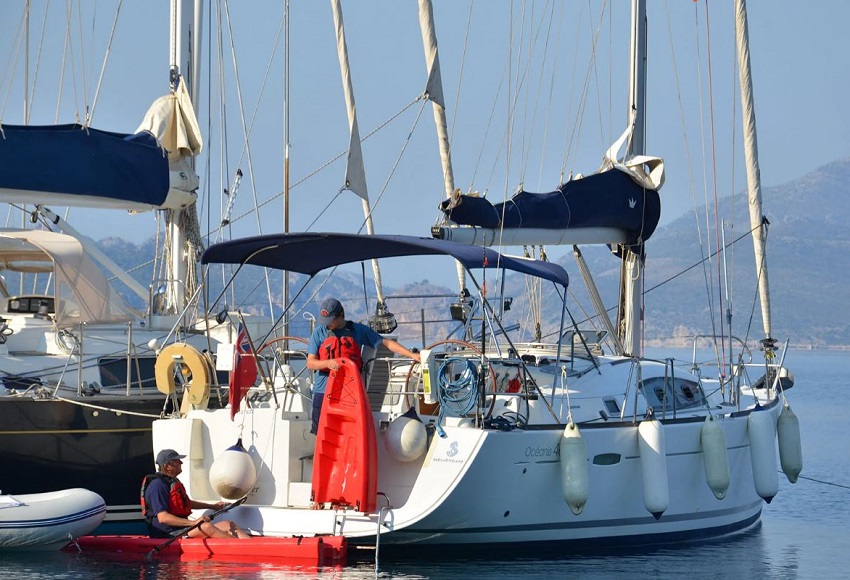
Every modular kayak is composed of standardized units/sections that can easily be assembled. While they’re not flexible in arrangement (you have to put them together in the right order to build a functioning kayak), they are self-contained units that are easily connected.
Most modular kayaks feature some sort of tongue-and-groove connectors that, together with rubber or silicone gaskets, create a watertight seal between the multiple sections.
Many also include a latch or ratchet strap that not only holds the compartments together, but actually pulls them tight against each other to ensure full waterproofing.
They come in both sit-inside and sit-on-top models (as you saw by our list above), with designs suited to fishing (complete with gear mounts and rod holders), touring, recreational kayaking, even whitewater paddling.
What’s cool is that some modular kayaks (not all) are designed to be versatile enough to adapt to multiple configurations.
For example, the Point 65N Martini GTX is built with multiple compartments/sections that allow you to transform it from a 9’4” solo kayak to a 13’8” tandem kayak. All you have to do is add the extra section to make it tandem, or use the single section to make it solo.
This gives you total flexibility in how you want to use the kayak. You can switch it back and forth between solo and tandem with minimal effort.
You’ll love this flexibility if you tend to paddle solo but occasionally want to bring a partner, or vice versa. Just add or remove the extra compartment, latch it tight, and you’re off to paddle.
Pros and Cons of a Modular Kayak
What makes a modular kayak an option worth considering instead of, say, your standard hardshell or a cheaper inflatable kayak?
Modular vs. Hardshell Kayak: Pros
- More portable; can be packed down small
- Requires less storage space
- Equally sturdy
- Flexible design—can switch between tandem and solo
Modular vs. Hardshell Kayak: Cons
- Significantly more expensive
- Fewer models available
- Will require more maintenance
Modular vs. Inflatable Kayak: Pros
- Sturdier; paddles and handles like a hard-shell kayak
- Can handle impacts and scrapes without sustaining damage
- Significantly longer lifespan
- More storage space and accessory options
Modular vs. Inflatable Kayak: Cons
- Much pricier
- Slightly less packable and portable
- Heavier
As you can see, there are great reasons to consider a modular kayak, but the design does come with a few drawbacks by comparison.
Assembling Your Modular Kayak
You might think that assembling a modular kayak can be time-consuming and tricky. After all, you’ve got multiple sections/compartments that have to be assembled, so surely that’s going to be the most challenging part of the kayak design, right?
Well, yes, you’d technically be correct—assembling your modular kayak does take more time than just lifting your fully assembled hard-shell kayak down from your roof rack. However, it’s far quicker and less of a hassle to snap together a modular kayak than filling an inflatable kayak with a foot or hand pump.
As I mentioned above, most modular kayaks feature a tongue-and-groove design. One compartment has a tongue (extending outward) that slides into the groove (embedded inward) to create the strong connection. Add in a rubber or silicone gasket, and you’ve got yourself a kayak that is as reliable and waterproof as your average hard-shell kayak.
It can be a bit tricky to get the assembly process right, especially at first. You’ll have to learn how to slide the tongue into the groove, how to keep the two compartments/sections together while you close the latch or tighten the ratchet strap, and the best way to assemble the various components efficiently.
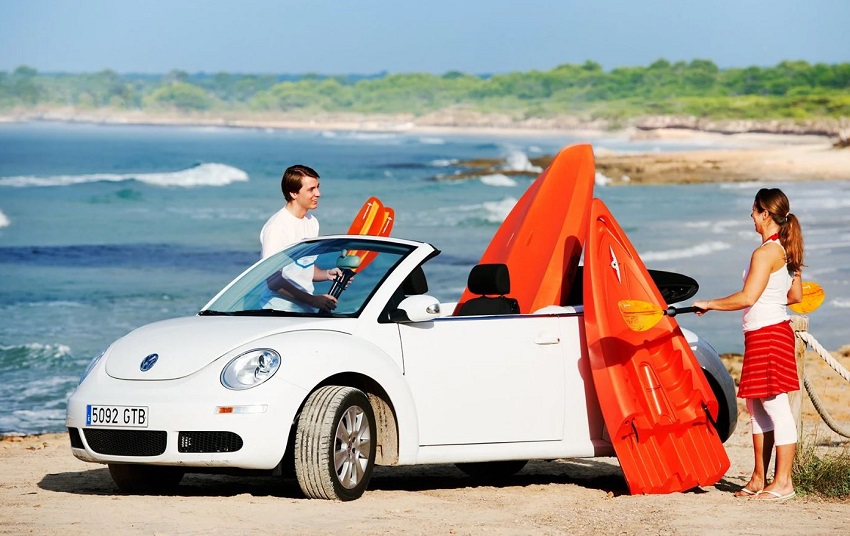
But really, that’s just the first few times. Once you see how it’s done, you’ll realize that it’s actually insanely easy to assemble a modular kayak with a bit of practice.
Watch this video by the good folks at Carolina Campervan, and you’ll see what I mean. He spends more time showing you all the various components than he does assembling the kayak—it’s just that easy!
This video from Point 65N shows how this particular line of kayaks is assembled, as well as the ease with which you can transform it from solo to tandem and back again.
A Word of Warning
Before you assemble any modular kayak, it’s important that you take the time to read the product manual. Each manual will tell you the specific steps to follow, as well as any critical details to know about—details that might affect the durability or structure of the kayak.
For example, check out various manuals at Point 65N Product Instruction page. As you can see, there are a number of instructions that you’ll need to follow or situations to avoid in order to prevent damage to the locking system. The Point 65N latches may be damaged if you carry something heavy in the kayak, drag the kayak when assembled in tandem form, carry it with someone sitting inside, or paddling in very high surf.
However, compare that to the other company that makes modular kayaks, Pakayak, and there’s no such limitations.
What is “right” for one modular kayak brand may be “wrong” for another, or what causes damage to one may be utterly harmless to another.
That’s why it’s so important to read the manual before setting out to assemble the modular kayak. It’s the best way to make sure you’re not only building it correctly, but avoiding doing anything that might damage the locking system or the various components.
Buying the Right Modular Kayak: Factors to Consider
By now, you’ve got a much clearer idea of what a modular kayak is, what it can do, how it can benefit you, and what its potential flaws and drawbacks are.
If you’re thinking that this type of kayak might suit you well—better than a hardshell or inflatable kayak—then it’s time to dive into the nitty-gritty details on how to find and buy the right modular kayak.
There are a lot of buying factors to consider, all of which will inform your final choice of which brand and model to choose. Let’s take a look at the most important ones:
Intended Use
If you’ve ever tried fishing in a whitewater kayak or taken a recreational kayak into the ocean, you’ll know exactly what I mean when I say it’s VERY important to buy the right kayak for your intended use.
Kayaks are designed for specific activities—for example, fishing kayaks are designed to be steady and stable even when you’re standing up, allowing you to cast out a line and battle a stubborn fish. Touring kayaks are built for speed and stability on choppy oceans, while whitewater kayaks are built far tougher and capable of enduring a beating.
Whatever type of paddling you intend to do, whatever your destination, that is the type of kayak you should buy.
Like standard hard-shell kayaks, modular kayaks come in the usual types:
- Recreational (sit-inside)
- Fishing (sit-on-top)
- Touring/Expedition (sit-inside)
- Whitewater (sit-inside)
Choose the kayak that suits your intended use best.
Weight Capacity
Weight capacity refers to the amount of weight that your kayak can carry without being overloaded. When it’s overloaded, it rides lower in the water, which makes it more prone to filling with water and ultimately capsizing.
Kayak manufacturers will typically make their products’ weight capacity very clear. You can see it on their website or sales page—usually as “weight capacity” or “payload”.
What’s important to remember is that the weight capacity is total weight, not just you, but also your equipment (paddle, PFD, etc.), accessories (fishing rod holders, fishing rods, trolling motor), and stored gear (food, water, clothes, etc.).
If you’re paddling for a few hours around a lake, you don’t really need to pack much gear. Just a bit of food and water, maybe a sweater or jacket in case it gets cold, and you’re good to go. For a trip like this, you can find a kayak with a weight capacity only slightly higher than your weight.
However, when you start getting into more advanced, longer-lasting activities, that’s when weight capacity begins to matter. For example:
- You’re going kayak fishing, so you want to bring a cooler filled with ice for any fish you catch, another cooler with ice for your drinks, a big bait box, and a trolling motor with the electric battery.
- You’re taking a two-day paddling trip out to a nearby island off the coast, which means you’ll need to carry enough food, water, and supplies for the overnight trip.
- You’re paddling upriver with your buddies planning to camp at a remote location, so you’ll be hauling tents, cooking equipment, GPS devices, clothes, food and water, and more.
Depending on what you’re doing, the amount of gear you pack might end up weighing a lot more than you realize. You’ve got to make sure your kayak can handle the weight—or, keep the weight capacity in mind when packing, and weigh yourself and your gear to make sure you’re under the recommended payload.
Storage Capacity
Not all kayaks feature storage.
Many sit-on-top fishing kayaks will have sections where you can lash down tackle boxes, coolers, or gear, but there will be no dedicated compartments.
Most sit-inside kayaks will feature watertight compartments sealed by hatches, but not all, especially the lower-budget models. Or, if there is storage space, it’s either not watertight, or so minimal that you can’t carry more than a 30-liter dry bag.
Again, this isn’t going to be much of an issue if you’re just enjoying a short, relaxing paddle around a lake. You don’t need much in the way of gear or supplies for that type of activity.
But if you’re fishing, traveling for a day or three, or needing to carry more gear for camping or trekking, storage space (especially watertight storage space) may be a very real concern to consider when shopping for modular kayaks.
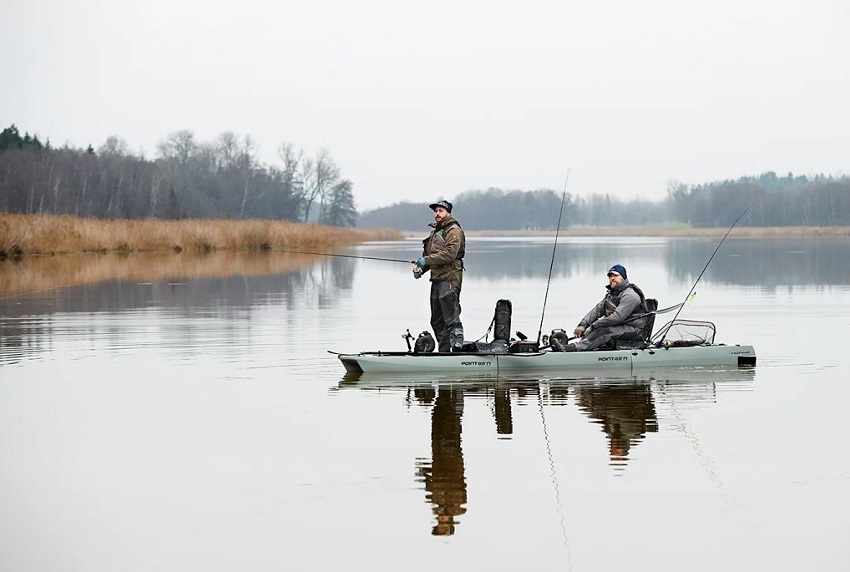
Paddler Skill
Your skill will usually go hand-in-hand with your intended use.
For example, you may be a deft hand at fishing—even from a kayak—but you’ve never tried whitewater kayaking before. Or, you can handle a recreational kayak like a boss, but the high secondary stability of a touring kayak feels unstable and imbalanced to you.
Consider a kayak that A) you will use regularly, and B) you feel comfortable to use.
You can definitely buy a new type of kayak that you’ve never tried before if you plan on attempting a new form of kayaking—for example, trying sea touring or whitewater kayaking. That’s how you grow your skill as a paddler.
But if you’re just looking for a good kayak to use for the activities you already do, consider what will suit your current needs best and buy accordingly.
Weight
One area where inflatable (and foldable) kayaks often out-perform hard-shell kayaks is in weight. Typically, these more “portable” kayaks use less material, or the materials they use are lighter-weight, making the kayaks themselves lighter.
However, that isn’t the case with modular kayaks.
Modular kayaks are essentially built exactly the same as hard-shell kayaks, with one simple difference: they can be assembled and disassembled. The ratchet straps or latch system won’t add a lot of weight, nor will the silicone or rubber gaskets. Thus, a modular kayak will weigh roughly the same as a standard hard-shell.
This might not be a problem. Your average solo recreational kayak typically weighs less than 35 pounds, which pretty much anyone can carry. The fact that you can add another module to turn it into a tandem kayak actually makes it a better option for you than a standard tandem hard-shell.
However, for those who can’t handle a lot of weight, it may be a bit of a hassle to haul two or three modular pieces to and from the water every time you want to use it.
That’s not to say that you shouldn’t consider a modular kayak if you’re not up to carrying the weight; it’s just important to consider how much the kayak weighs when you’re shopping for the “right” model for you.
Portability
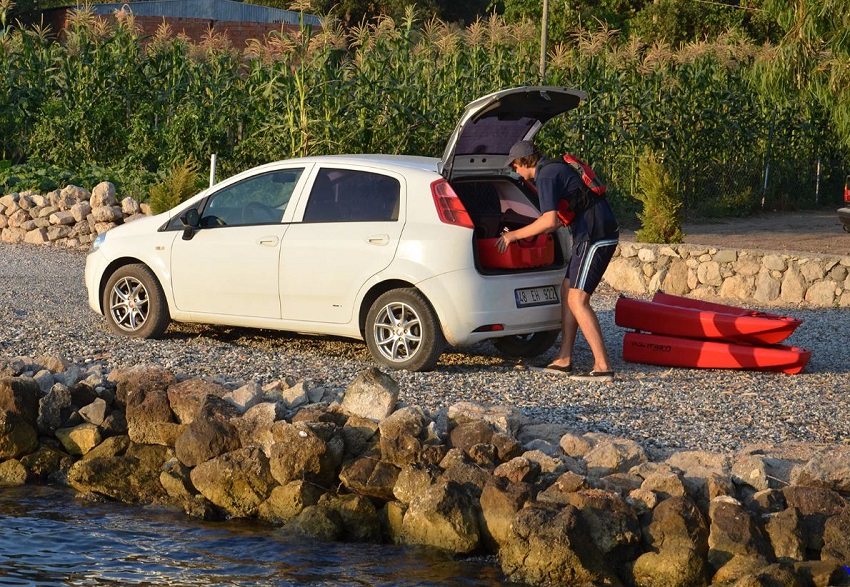
Modular kayaks are significantly more portable than hard-shell kayaks, thanks to the fact that they can be disassembled into 2-3 parts. You won’t have to load them up on a roof rack or store them fully assembled in your garage.
However, bear in mind that they won’t be quite as portable as foldable or inflatable kayaks. Because they’re hard-shell (just in components), they’ll still take up space in your vehicle or garage.
Typically, the largest of the kayak components will be around 5’ long, with each modular section varying in length. Some will stackable, so they take up less space, but ultimately, they will take up space and be less portable than a foldable or inflatable.
This is no problem if you’ve got a slightly larger vehicle or a roomy trunk. It’s just a factor to consider when evaluating how you’ll transport the kayak to and from the water.
Number of Sections
Modular kayaks can come in any number of sections—typically, 2-6 for a solo kayak, and 3-8 for a tandem kayak.
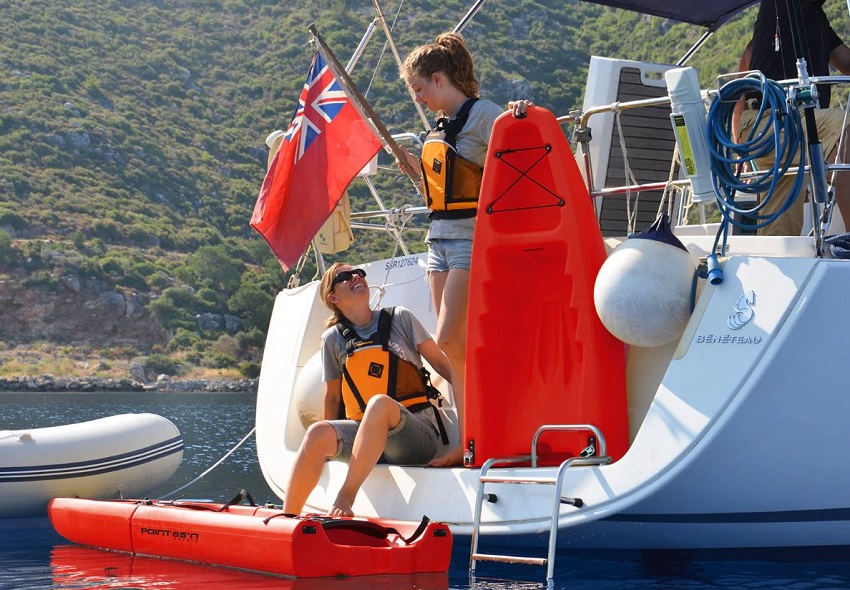
Some kayaks, like the Pakayak option we listed above, will stack down small enough to fit inside a large suitcase-sized bag. When the time comes to assemble it, there are more components/sections, so it takes a few minutes longer.
On the other hand, the Point 65N kayaks are built in fewer sections, which means there is less assembly time required, but the sections will be larger and heavier.
Difficulty of Assembly
As you saw by the videos I shared above, the assembly process of modular kayaks tends to be fairly easy. For the average person, that is.
Some people may struggle to connect the ratchet straps, or ratchet them tightly enough to ensure the kayak is secure.
Others may have a hard time maneuvering heavy components/sections into place to connect them properly.
It’s worth spending a few minutes watching videos on YouTube or manufacturer websites to see just how much effort goes into assembling the modular kayaks.
Durability
Durability is always an important factor to consider.
Over the course of your paddling trips, you can expect for the kayak to sustain at least some damage. For example:
- Grinding on rocky lakeshores or underwater coral
- Hitting a submerged tree or a rock jutting out of the water
- Colliding with a fellow kayaker or a docked boat
No matter how skilled you are, there will be some damage inflicted over time. It’s important that you consider a kayak that can withstand that sort of damage and stay sturdy for years to come.
Typically, modular kayaks are made of the same materials as hard-shell kayaks—either rotomolded polyethylene or thermoplastic. Both can handle a lot of abuse without breaking or cracking, and are able to withstand both high and low temperatures (above 90F and below 30F).
However, plastic is notably susceptible to damage by UV light. The more time you spend in the sun, the more the plastic’s color will fade, and that fading is an indication that the material is weakening. That’s why it’s so important to keep your kayaks protected from direct exposure to sunlight when not in use.
Another factor to consider is the connector system. Typically, that involves three components:
- The joint itself. Usually, you’ll be looking at some form of tongue and groove system. The tongue is the part most likely to be damaged, but the groove can be damaged if used incorrectly, too. Damage to either parts of the joint could compromise both waterproofing and structural integrity.
- The waterproofing gasket. Most modular kayaks feature a gasket of rubber or silicone that will ensure a tight, waterproof union between the sections. Silicone is the sturdier and lighter of the two materials, less likely to be damaged or degrade with regular use. Thankfully, many modular kayaks sell replacement gaskets that can be easily swapped out for an existing damaged gasket.
- The connector. You’re looking at either some form of latch or ratcheting system that ensures the modular components stay securely connected. Some ratchet straps may be built from plastic (similar to snowboard boot straps), while many latch-style connectors are built using stainless steel. Both are prone to damage and wear with regular use, but it’s safe to say the steel connectors are longer-lasting.
Handling and Tracking
When considering any kayak, you’ve got to evaluate how well it handles and tracks. After all, the better the handling/tracking, the more efficient your paddling trip will be—more time making forward progress, and less time and effort invested course-correcting.
Typically, hard-shell kayaks handle and track significantly better than inflatable kayaks, as well as many foldable kayaks. Their sturdy frame just moves more efficiently through the water, and there’s a more solid platform to push against as you paddle.
Because they’re built like hard-shell kayaks, modular kayaks will handle pretty much as efficiently. You can test various models to see which suits you best, but you can trust that your modular kayak will handle/track great.
Comfort and Fit
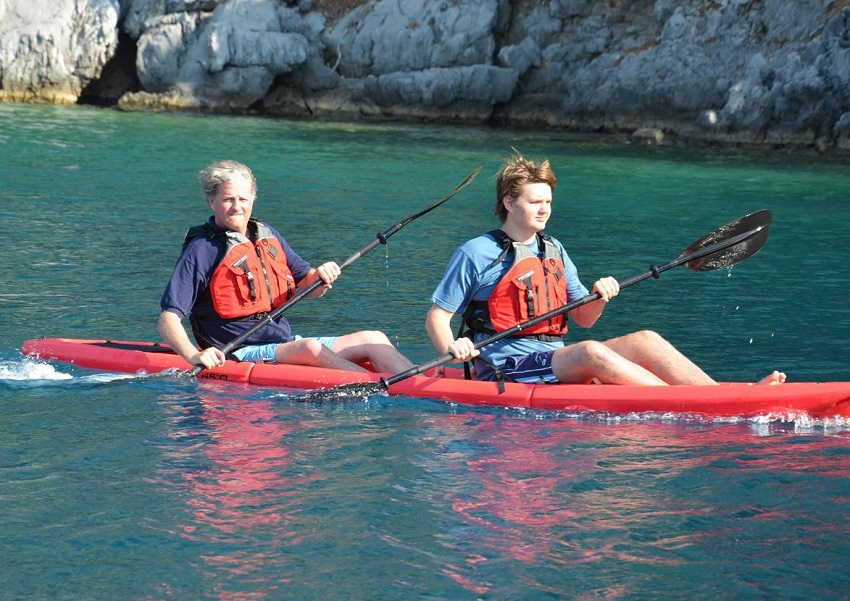
As always, you’ve got to take your size and the size of the kayak itself into account.
For the “average” person (under 6’), “most” kayaks will suit them just fine. Sit-inside cockpits are largely built for the average paddler size, with enough room to move around and swing your arms to paddle. Sit-on-top kayaks will have more room to stretch out, making it easier to get comfortable for long hours.
However, for extra-tall paddlers (like me, at 6’6”) and extra-short paddlers (anyone under 5’), fit becomes an important factor to consider. You’ve got to make sure you not only have enough leg room, but also space to enter/exit the kayak quickly.
Comfort is another important factor that often goes hand-in-hand with fit. When the kayak is sized right, you will be able to paddle comfortably, with room to stretch out and shift your legs to keep blood flowing.
But you’ve also got to evaluate things like the seat (both the cushioning underneath you and the back support), as well as things like knee and hip pads that let you brace against the kayak comfortably while paddling.
Extra Features and Accessories
Extra features can make using your kayak a whole lot easier and more comfortable! It’s worth considering extras like:
- Grab handles
- Bungee straps (front and back)
- Drinks/bottle holders (one of my wife’s favorite additions to her Pelican Summit 100X)
- Fishing rod holders/mounts
- Track mount holders
- Rails for accessories
- Trolling motor mount (or compatibility with a mount)
These things can make heading out on the water for a day of leisurely paddling and/or fishing a whole lot more enjoyable.
One very important extra feature to consider is compatibility with a spray skirt.
Spray skirts are almost a must-have for windy, choppy, and cold paddling conditions. They’ll keep the water (mostly) out of your kayak, keeping you (mostly) dry and warm. They’re a game-changer if the wind is up, the waves are high, or there’s a lot of chilly ocean spray.
Some modular kayaks will only be compatible with spray skirts manufactured by the same brand, while others will work with universal spray skirts.
Price
Last, but definitely not least, consider the price of the modular kayak.
Typically, modular kayaks will cost notably more than a hard-shell kayak—anywhere from 25% more to double the price. You’re paying extra for the portability factor, which requires much more complex engineering and manufacturing to create a kayak that can retain its hard-shell durability while still being collapsible.
A modular kayak will definitely cost far more than an inflatable kayak, too, but it’s well worth it if you want a sturdy, reliable kayak that handles like a hard-shell but is as portable as an inflatable.
Modular Kayaks FAQ
Well-built, properly assembled modular kayaks are nearly as tough as hard-shell kayaks. The addition of joints will create some flaws and weaknesses in the structure, but when connected securely, the structural integrity is more than sufficient for all but the most hardcore use.
If you want to keep it very cheap, lightweight, and portable, inflatable kayaks are the better choice. But if you prefer durability, don’t mind paying a bit more, and have the trunk room to spare, a modular kayak will be more reliable and last longer.
Some modular kayaks (like the Point 65N kayaks listed above) advise against paddling in any water with waves higher than 3 feet. However, the Pakayak kayak that is our “Best Overall” is built to handle even larger swells.
Absolutely! Though they’re more expensive than inflatable kayaks, they’re just as portable, and as tough as a hard-shell kayak. They’re sort of the best of both worlds, well worth the expense if you want a sturdy, reliable kayak you can take on the road in your small vehicle.



